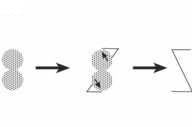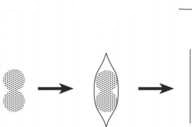Modified Burow's advancement flaps for two circular adjoining cutaneous defects: The 8-to-S-plasty
Published Web Location
https://doi.org/10.5070/D345q265snMain Content
Modified Burow's advancement flaps for two circular adjoining cutaneous defects: The "8"-to-"S"-plasty.
Georg A Barth MD
Dermatology Online Journal 11 (1): 10
Pasinger Bahnhofsplatz, München Germany
Abstract
The traditional method to close two closely approximated cutaneous defects (i.e., a fiugre "8"-shaped defect) sacrifices healthy skin and does not give optimal aesthetic results. We report a case with modified Burow's advancement flaps describing less sacrificed skin and shorter scars. Modified Burow's advancement flaps ("8"-to-"S" plasty) were applied, sparing two Burow skin triangles. Application of that modified operation technique leads to shorter scars in comparison to traditional Burow's advancement flaps. A modified technique is presented here for skin defects shaped like an "8"—namely, two similar round and adjoining lesions. The suture line after closing resembles an "S". With this 8-to-S plasty no additional incisions are necessary.
Introduction
The use of Burow's advancement flaps or elliptical excisions are traditional methods to close a lesion shaped like an "8" (Fig. 1). But, in both cases unaffected skin has to be sacrificed and additional incisions have to be made. In order to spare healthy skin and to reconstruct such a 8-shaped defect, we developed a modified skin-surgery technique. It consists of modified Burow's advancement flaps. In our hands the new technique leads to good cosmetic results and shorter scars.
Clinical synopsis
The patient is an 59-year-old man with two basal-cell carcinomas on his back. The defects are round and adjoining (Fig. 2). After undermining, the two flaps are translocated into the defects and are fixed with subcutaneous stitches (resorbable monofilament Polydioxanone) (Fig. 3). Postoperative healing proceeded without complications.
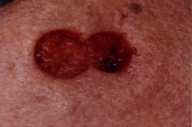
|
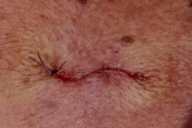
|
| Figure 2 | Figure 3 |
|---|---|
| The 8-shaped defect (diameters 25 mm and 23 mm) (Fig. 2). | |
| The S-shaped suture line (Fig. 3). | |
Discussion
The Burow's advancement flap is a frequently used and versatile technique in dermatologic surgery [1, 2]. Boggio et al. [3] and Kaufmann and Landes [4, 5] have described Burow's triangle advancement flaps for excision of two closely approximated skin lesions.
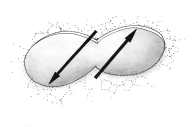
|
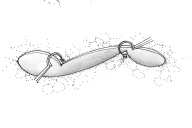
|
| Figure 4a | Figure 4b |
|---|---|
| The 8-to-S-Plasty | |
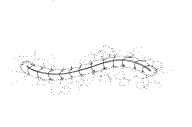
|
| Figure 4c |
|---|
We describe a case with a modification of this technique (Figs. 4a-4c). The advantages of this modification compared to classic elliptical excision or traditional Burow's advancement flaps are significant. With both traditional techniques, more incisions must be performed and healthy skin (i.e., triangles) must be sacrificed.

|
| Figure 5 |
|---|
| The S-shaped scar after 7 weeks. |
Further advantages of the 8-to-S plasty are shorter execution time, a less invasive approach, and good aesthetic results by hiding the S-shaped suture line within relaxed skin tension lines (Fig. 5).
References
1. Petres J, Rompel R. Operative Dermatologie.Berlin: Springer, 1996:632. Robinson JK, Arndt KA, Leboit PE, Wintroub BU. Atlas of cutanous surgery. Philadelphia, London, Toronto, Montreal, Sydney, Tokyo: W.B. Saunders Company, 1996:113
3. Boggio P, Gattoni M, Zanetta R, Leigheb G. Burow's triangle advancement flaps for excision of two closely approximated skin lesions. Dermatol Surg 1999;25(8):622-625
4. Kaufmann R, Landes E. Simultaneous excion of two basal cell carcinomas. In: Kaufmann R, ed. Interventi dermochirurgici. Milano: Masson, 1994: 133.
5. Kaufmann R, Landes E. Simultaneous excion of two pigmented lesions. In: Kaufmann R, ed. Interventi dermochirurgici. Milano: Masson, 1994: 217.
© 2005 Dermatology Online Journal


